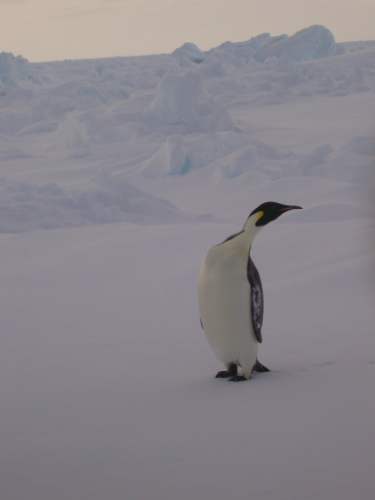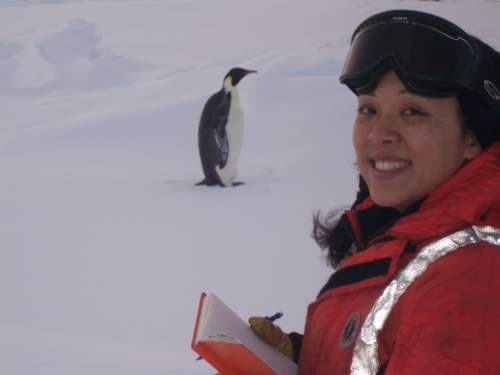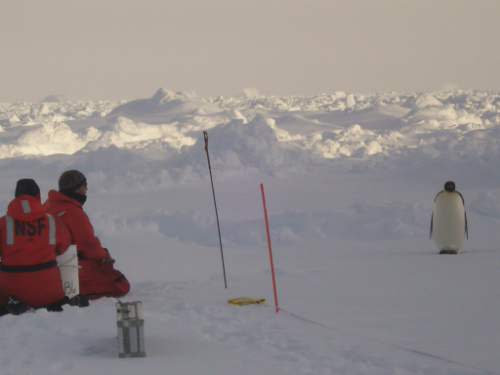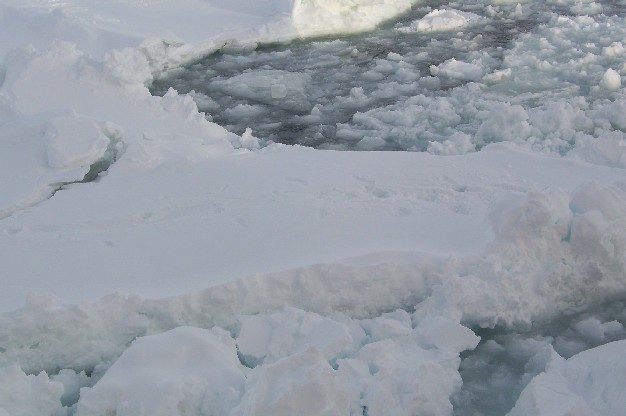Location: In the ice, in the Bellingshausen Sea.
Latitude: 70° 24¢ S Longitude: 90° 28° W Air temperature: -3.5° C (25.7° F) Water temperature: **-1.8° C (28.6° F) **Relative humidity: 74.2% Barometric pressure: 961.9 mBar
Antarctic trivia (answer at the end of this journal entry): Are there any volcanoes in Antarctica?
When I first saw him (or was it a her?) out of the corner of my eye, I thought it was a seal sliding into our ice station. But this was no seal coming to pay the ice party a visit, it was a penguin! The species was easy to recognize, an Emperor without a doubt, and not a small one! He appeared from out of the water behind the boat and slid on his belly into the middle of the science party working on the ice. He extended his wings to the side, pulled himself up to a standing position, ruffled and preened a bit, posed for a few pictures, then supervised operations for the next thirty minutes.
 The emperor poses for a picture.
The emperor poses for a picture.
 Penny takes a break from recording data to pose with the visitor.
Penny takes a break from recording data to pose with the visitor.
I was on the bridge observing this scene. Even from 4 stories up this penguin looked huge. It stood waist high and we estimated that it weighed 60-70 pounds. The Antarctic Treaty forbids us from doing things that would alter the behavior of wildlife, so we could not approach the penguin, though he seemed like he wanted a little company! Penguins are social creatures, congregating in large groups and often approaching researchers working in Antarctica. The scientists on the ice stopped work to take pictures of him, then resumed their operations. The penguin moved from group to group, seemingly making sure everyone was doing their job properly.
 Chris and Beverly are supervised by the visitor.
Chris and Beverly are supervised by the visitor.
Emperor penguins live exclusively in the water and on sea ice, never touching the ground during their lives. Male Emperor penguins share in chick-rearing duties with the females. Female Emperors lay a single egg in the coldest part of winter. The male then incubates the egg for nearly two months by carrying it on his feet and covering it with a fold of skin and feathers. The male can’t go in the water during this time, so he lives off the fat he stored before the breeding season. While the male incubates the egg, the female takes to the water to feed, returning around the time the chick hatches. The female cares for the chick while the male feeds, after which both parents care for the chick. The chick is ready to be on its own in about five months. If things work out right, this is about the time the sea ice is breaking up in the spring and the juvenile Emperors will be carried out to sea. If the winter is especially hard the sea ice may not break apart soon enough to carry the chicks to their feeding grounds and many chicks may die. What a tough life!
 Penguin tracks in the snow.
Penguin tracks in the snow.
If you look closely at the picture above you can see where the penguin pulled himself up on the ice floe, then got on his belly and began to slide. Emperor penguins can’t jump or climb like other species, so it’s not always easy for them to get out of the water or move around on rough ice.
Try this: Look around your school yard, neighborhood, or a park for evidence of animal life. Can you find tracks in the soil, droppings, or other signs that an animal has been there? What does the evidence you find tell you about how the animal lives?
We definitely had an exciting time today…after our data collection in the morning the ship resumed travel. We’re scheduled for a midnight stop and another round of data collection. I’ll be part of the data collection team this time, so I better go get my cold weather gear together!
** Answer to today’s Antarctic trivia question: **Are there any volcanoes in Antarctica? Yes, there are volcanoes in Antarctica, but they are covered with ice. Their lava and steam melt some of the ice causing portions of the remaining ice to start to slide – this is called an ice stream. Mt. Erebus is a well known volcano that is 12,444 feet high.
Marine mammals and sea birds spotted today by Brent: Snow petrel Giant petrel Ross seal Emperor penguin

